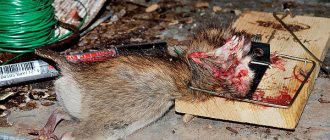Difficulties in fighting rats in a chicken coop
The most effective remedies for rats are crush traps and poisons; they allow you to remove rodents almost always and from any room. However, as you understand, these products are also dangerous for chickens: if a bird steps on a trap, the triggered spring may well break its leg, and poisoning chickens with rat poison in many cases ends in their death.
Thus, in most cases it is impossible to poison rats directly in the chicken coop. Even if you place poisoned bait in special shelters that are inaccessible to chickens, rats can take it throughout the chicken coop, and thus the problem does not disappear.
So, the idea of simply taking and placing crushers in the chicken coop, or pouring poison in the corners, should be abandoned immediately: the product should be inaccessible to birds, but at the same time rodents should be able to easily get to it.
This problem can be solved, but its solution involves some technical difficulties - you will have to create a special design to protect chickens from injury and poisoning. We’ll talk about how to do this, and thereby most effectively fight rats, a little lower.
Various folk remedies for rats in a chicken coop for the most part turn out to be ineffective, and you can’t rely on them alone, although sometimes some such remedies can also give a certain result.
Damage from rodents in a chicken coop
The rat is an intelligent and complex animal. She is able to defeat a cat and injure a dog. And in the chicken coop she is calm, safe and has something to enjoy. For permanent residents - chickens, rats pose a particular danger because they:
- They carry dangerous infections that affect not only birds, but also humans.
- Birds are infected with helminths, fleas and ticks.
- They eat food from trays consisting of grains, root vegetables and vitamin supplements.
- Rats steal eggs from the chicken coop, considering them a delicacy.
- Hatched chickens and young animals are killed.
- They cause harm to the health of adults by biting off scales on their paws during sleep, which leads to stress in the birds, and this, in turn, negatively affects egg production and weight gain.
Rats are not stopped by strong walls and concrete foundations. In the hunt for food, they gnaw passages, make tunnels, and get to the delicacies that are in the chicken coop by any means. It’s amazing how rats steal eggs.
Exterminating rats in the chicken coop: basic tools
In most cases, you can kill rats in a chicken coop using rat traps, which are inaccessible to chickens. There are two ways to ensure this inaccessibility:
- The trap is charged and placed in a box with a hole 5-6 cm in diameter, through which only a rat can fit. A strong-smelling product is used as bait - for example, a piece of fried meat or bread with vegetable oil. The method is suitable for any chicken coops, except those in which small chickens live;
- Or the crusher is placed on the upper shelves, on which tools or various rubbish are stored and which the chickens cannot reach. Of course, the trap here will only work if the rats themselves are running along these shelves.
It is also useful to read: The best baits for rats and mice: what do these rodents love most?
Another option is to catch the rat alive in the chicken coop. It is safe for birds, since chickens will not fall into the live trap, but it is associated with some difficulties in operating the live traps themselves: you will need to get the rat out of the trap so that it does not bite you, and then you will still need to do something with it (kill or release). In addition, live traps are more expensive than crusher dies.
Rats in a chicken coop can also be controlled using ultrasonic rodent repellers. Good powerful devices really scare away rats and do not allow them to enter the chicken coop, but such repellers are quite expensive (much more expensive than poison and rat traps). Cheap “tweeters” are less likely to produce results, the less they cost.
And only extremely rarely can you exterminate rats in a chicken coop using poison. We will also talk in more detail about how to do this correctly.
Traps in the chicken coop and the specifics of their use
The easiest way to get rid of rats in a chicken coop is to use a rat trap in a special protective box. The implementation of the design is quite simple:
- Take any box of sufficient size, cardboard or wood;
- Several holes with a diameter of 5-6 cm are cut in its walls right near the bottom;
- A loaded trap with bait is placed at the bottom of the box;
- The box is closed as tightly as possible, and its lid or opening flaps are sealed with tape. This is necessary so that if the chickens turn it over, it does not open;
- The entire structure is installed under one of the perches.
You can check this trap about once a day by removing the tape and opening the box.
On a note
There are special houses on sale today in which you can place both traps and poisons for rats, but due to their relatively high cost they are not in great demand.
It is easier to work with a live trap - it is simply charged and installed anywhere in the chicken coop. What to do with a caught rat is up to each chicken coop owner to decide for himself. Usually they just give it to the cat. The only question here is whether a rat trap is needed if a cat lives on the property...
It is important to remember that there may be several rats in a chicken coop, and traps should be used as long as pests continue to be caught in them periodically. If not a single rat has been caught in two weeks, then we can conclude that there are no rats left in the chicken coop.
How to properly use rat repellers in a chicken coop?
Reliable protection of the chicken coop from rats can only be provided by sufficiently powerful repellers. In particular, the effectiveness of the Chiston-2 and Chiston-2 PRO devices, as well as the Bioguard, was tested - according to the results of the experiments, they made it possible to get rid of rats and mice in the premises in approximately 9 cases out of 10.
Such repellers are quite expensive:
- Chiston-2 - approximately 2000 rubles;
- Chiston-2 PRO - about 3,000 rubles;
- Chiston-4 Bioguard - about 4,000 rubles.
There are also many less reliable ultrasonic rat and mouse repellers, and, as a rule, the less the device costs, the lower the likelihood that it will actually help get rid of rodents. However, sometimes even inexpensive models work.
The repeller is installed directly in the chicken coop, plugged into an outlet and works constantly. Practice shows that when using a powerful device, rats leave not only the chicken coop, but also the adjacent buildings.
However, even if a fairly powerful device works constantly, there is a risk that rats running into its area from time to time will cease to be afraid of it. Therefore, after the result is obtained, measures should be taken that in the future simply physically will not allow rats to enter the chicken coop.
On a note
It should be borne in mind that ultrasonic radiation is effective only in the area where the repeller is directed and, like rays of light, cannot overcome physical obstacles - walls, partitions, etc. In addition, it is not recommended for a person to remain in the area of operation of a working device, especially a powerful one, for a long time. In some cases, this can cause headaches or ringing in the ears, so it is recommended to turn off the device before doing any work in the coop.
Poison in the chicken coop. In no case?
It should be understood that no matter what the poisoned bait for rats is and no matter what it looks like, there will definitely be chickens who will find it and taste it. Moreover, if the owner of the chicken coop himself is not particularly worried about choosing a product. As a result, there are numerous cases of chicken poisoning with rat poison, most of which resulted in the death of the birds.
The main symptoms of chickens being poisoned by rat poison are refusal to feed, lethargy, ruffled feathers, incoordination, trembling, convulsions, vomiting and bloody droppings. These signs may appear immediately or within 1-5 days, depending on the toxic substance.
In cases of poisoning of a large number of birds, it is advisable to contact a veterinarian to provide qualified assistance; in case of isolated poisonings, you can act independently. Your task is to remove the toxin from the body as quickly as possible. To do this, you need to rinse the stomach with a weak solution of potassium permanganate or activated carbon by oral administration (you can use a syringe) in a volume of up to 2/3 of the crop.
On a note
You should not eat eggs or meat from birds that have been poisoned. There are known cases of poisoning by the eggs of such chickens even 10 days after treatment. Depending on the toxic substance, the process of removing the poison from the bird's body can take more than 2 weeks. A veterinarian can give an accurate prognosis.
But let’s return to the considered method of getting rid of rodents in a chicken coop using poison and note another of its inconveniences - the need to search for and collect dead rats in order to avoid infecting domestic animals with pathogens, the appearance of an unpleasant odor, as well as possible eating by their relatives.
As a result, there are only two acceptable ways to exterminate rats in a chicken coop using poison:
- All chickens are temporarily transferred to another room, and poison, for example, “Rat Death” or “Zookoumarin” is laid out in the old chicken coop. The rats die, then the chicken coop is cleaned and the birds return. To implement this method, additional space and about a week or two of time are required;
- Another option is possible - the same box is placed in the chicken coop as for installing a rat trap. A heavy ceramic plate is placed in the box and beer is poured with the addition of liquid poison for rats (Brommus, Bromed, Brodifan, Indan-Fluid, etc.). The principle here is that rats willingly drink beer and smell it well, but they will only be able to eat poison in the closed box itself, where chickens will not get into. The same can be done if you replace the beer with milk, but in this case the process may take longer because the milk does not smell as strong and rats may not immediately detect it.
It is also useful to read: How to reliably get rid of rats and mice in your private home
As in the case of traps, to prevent chickens from eating rat poison, it can be placed in special plastic houses available for sale today, which are analogues of homemade boxes. Here you should also use only liquid poisonous baits that the rats will not be able to pull out of the house. However, in general, these bait stations are quite expensive, and it can be easier to make your own from a cardboard box, which allows you to effectively get rid of rats without additional cost.
Ways to fight
To avoid having to worry about consuming chicken meat and eggs, it is necessary to actively fight rats from the first day.
Today there are a lot of chemical and mechanical traps on the market. They are excellent in exterminating rodents. You can also resort to traditional methods, or contact a special service. Any method will be useful, the main thing is to get rid of the unwanted neighborhood as quickly as possible.
When spreading poisons and baits, you must use gloves. Uninvited guests can smell a person well and will not approach the thrown treat if they smell the aroma.
Traps
The market is full of unique traps, and some of them you can make yourself:
- Rat trap. It is made in the form of a cage with a closing door. Bait is placed inside the structures. When the pest touches the food, the door will slam shut. It will remain alive, so you should be careful so that the animal does not bite or run away;
- Trap. The product consists of a wooden platform, a bracket and a spring. Using bait, the animal is lured into a trap. The spring is triggered and the animal dies;
- Electric trap. It is a box with bait inside. As soon as the pest gets inside, it is struck by an electric current and the animal dies. The trap is very effective, but it is not suitable for use in a chicken coop if there are chickens in it;
- Glue trap. To make it you will need cardboard, glue, and tasty bait. A thick layer of glue is applied to the cardboard and generously sprinkled with bait. The rat will not resist the treat and will stick to the cardboard.
Ultrasound
The fight against rats will be crowned with success if you use an ultrasonic unit. This method has advantages and disadvantages:
| pros | Minuses |
| The operation of ultrasonic equipment is aimed at irritating the sensitivity and nervous system of pests. | If rabbits live in the barn, then the use of ultrasound is unacceptable. |
| Ultrasound causes panic and discomfort in uninvited neighbors and remains harmless to the inhabitants of the poultry farm. | When choosing equipment, it is necessary to take into account its range of action. Perhaps one device will not be enough for the room in which the birds are located. |
| The equipment has the ability to change settings that help avoid addiction. | Not all ultrasound machines have settings. There are those whose frequency and type of sound do not change, so pests get used to them over time and stop being afraid. |
| Mice and moles are also afraid of outgoing ultrasound. | Ultrasound does not pass through hard and soft obstacles. If the room is divided by partitions, several such installations will be needed. |
| It is inexpensive, so such equipment is affordable for families with a small budget. |
When installing ultrasonic equipment, it is not recommended to cover holes. In panic attacks, if the animal has nowhere to hide, it can even attack a person.
Chemicals
Chemicals are used in aeration and in the form of poison baits. Carbonation requires special knowledge, so it is rarely used by ordinary farmers. It is mainly used on large poultry farms.
During gassing, carbon monoxide, chlorine and hydrogen phosphide are sprayed.
Rat repellents such as poisons are easy to use. The animal eats the poison and dies within a few hours or days. It all depends on the constituent substance.
However, the use of poisons has its disadvantages. Such chemicals pose a danger to people and birds. The most popular among farmers are:
- "Goliath". The substance causes oxygen starvation in animals. Rodents try to leave the room faster. The advantage of this method is that the farmer does not have to remove corpses from the premises. But the disadvantage of the substance is that it begins to act no earlier than after 10 days. During this period, rodents will have time to cause a lot of damage to the farm.
- "Rat Death" Its action is similar to the Goliath remedy.
- "Ratid 1" and "Ratid 2". These products are very similar to each other and do a good job of eliminating unwanted guests. But the second substance contains components due to which corpses mummify and do not decompose.
- "Krysin." A very powerful product that can kill a pest in 2 minutes. "Krysin" is easy to use. It must be mixed with seeds, sunflower oil or grain.
- "Mortorad." Another remedy that can mummify corpses. “Mortorad” is produced in the form of briquettes, which are laid out at a distance of 5 m from each other.
- "Zookoumarin." It contains elements that destroy pests in 7–9 days.
- "Carbide". He is thrown into a hole and filled with water. When they interact, gas is released. It is safe for birds and harmful to rodents. For greater efficiency, the hole is covered with earth.
Traditional methods
If it is not possible to purchase chemicals, you can use folk remedies. The main ones include:
- Ash. The floor in the chicken coop is sprinkled with it at the rate of 1 ten-liter bucket per 7 m2. The alkali contained in the ash has a negative effect on the digestive system of pests. If using this method it is not possible to completely get rid of rats, then it will definitely be possible to save the farm from fleas.
- Wool. It is necessary to set fire to any piece of woolen fabric and smoke the room with it. Burnt remains are scattered along the wall. Uninvited guests are afraid of the burning smell. They will take it as a signal of danger and leave the room. Some farmers pour alcohol over a rat carcass and fumigate the room with it.
- Baits with lime, alabaster or cement. You need to take flour or powdered sugar and add the indicated substances to them. You can place a bowl of water nearby to start the reaction. In any case, the pest will find somewhere to drink water.
- Smoked lard. It is placed on a wooden board and placed in a barrel filled with water. A ladder is placed next to it to make it easier for the rodent to get to the lard. It is better to set the barrel overnight and collect the catch in the morning.
Special services
If the method used could not help overcome the invasion of uninvited guests, then you should use the services of special services. Professionals use substances that infect rats and remain completely harmless to birds.
Therefore, with this treatment there is no need to move the chickens to another room. Also, the services of specialists include the removal of dead carcasses from the treated area. People who are afraid of rodents will appreciate this.
Cat or dog as chicken coop protector
Often, many owners of private households keep a cat on their property, but do not allow it into the chicken coop for fear that it will crush the hens or chickens. As a result, the most reliable and effective rat catcher remains out of work, and his owner has to rack his brains about how to deal with rats in the chicken coop.
In fact, cats almost never strangle poultry. Not only chicken owners, but often even pigeon keepers allow their pets to freely enter the dovecotes and catch mice and rats here. In rare cases, when a cat does strangle a chicken, punishing it once is enough to ensure that it does not repeat this in the future.
Therefore, if there is a cat living on the property that has already proven itself as a rat catcher, it makes sense to let it into the chicken coop to hunt for rats. It’s possible that you won’t have to do anything else to get rid of the pests.
Likewise, fox terriers or Jagd terriers happily hunt rats. True, they are less inclined to wait for hours for prey, sitting in a chicken coop, but often these dogs also help their owners get rid of rats without the use of additional methods and means.
Do folk remedies help get rid of rats?
But you shouldn’t rely too much on various folk remedies to protect the chicken coop. For example, there are widely known legends that rats are afraid of the smell of mint, tansy, burnt rubber and vinegar. There are even tips for removing rodents using perfumes, essential oils and tights.
In reality, such remedies rarely help get rid of rats. Even if pests are wary of a new smell or object in the chicken coop for the first few days, they will quickly get used to it and stop avoiding it. And in general, it can be quite problematic to discourage rats from a constant source of fresh chicken eggs using odors.
This is interesting
There is also an opinion that rats are afraid of guinea fowl. Allegedly, of all poultry, guinea fowl are for some reason so terrible for rats that they do not allow them to quietly run the chicken coop. In practice, this assumption is not confirmed, and even if several guinea fowl are placed in a chicken coop, the rats will not stop carrying eggs from here.
Folk remedies
If mechanical and biological means are ineffective, you can try folk remedies:
- Wood ash. It is scattered along the walls. It does not pose any danger to chickens, but the alkali present in it corrodes the paws of rats. It is activated when the rodent begins to lick its dirty paws. The appearance of discomfort forces them to leave the coop.
- A mixture of flour, alabaster, sugar and lime. Rats like its taste, but once inside, it causes organ burns and the rodents die.
- Barrel of water. It should be filled halfway with water, and pieces of lard should be placed on the surface. Place boxes near the barrel, making a kind of ladder out of them so that the rats can get to the treat, the smell of which they can smell well. All that remains is to collect and dispose of the corpses of drowned rodents.
How to protect a chicken coop from rats entering it?
It is important to remember that even if the rats were successfully removed from the chicken coop, it is necessary to provide protection against their re-entry. Otherwise, you will have to fight rodents regularly.
As a rule, to prevent rats from getting into the coop, it is enough to:
- Strengthen the earthen floor - remove a 40 cm layer of earth, fill in 30 cm of expanded clay and lay a fine mesh metal mesh (preferably with cells no more than 5x5 mm) over the entire area, then fill the earth back. It is important to ensure that such a barrier on the floor is no lower than the base of the foundation of the chicken coop, otherwise there will be little point in these measures;
- Or you can make a normal concrete floor, which will be sprinkled with sawdust or sand on top;
- You should also caulk all the cracks in the walls and roof through which rats can enter the chicken coop, caulk the joints between the walls and the foundation of the building, and ideally, make full-fledged stone walls. Even a half-brick wall will be an insurmountable barrier for a rat.
Of course, it is also necessary to keep the chicken coop clean - in this case, it will be easier to notice traces of rat activity, for example, broken eggs and rat excrement. The latter, by the way, is the easiest way to establish the presence of rodents.
On a note
Rat droppings are dark in color, reach 10-14 mm in length and are usually located in small piles. The simultaneous presence of large and small excrement already indicates the presence of some population of rodents (large and small animals).
Other telltale signs that should make you start dealing with rats as soon as possible:
- ammonia odor, especially strong in closed places;
- chewed surfaces – the constant growth of teeth forces rats to taste literally everything;
- “treadmills”, which are traces of rodent movement visible in dusty places.
And even more so, holes made at the junction of the foundation and walls, as well as eggshells next to them, clearly indicate that pests have gotten into the habit of dragging eggs here, and you need to start fighting them as soon as possible.
Interesting video: an example of how a cautious rat hunts in a chicken coop
It's easier to prevent than to fight
In order not to encounter uninvited guests in the barn, it is necessary to take all measures that can protect the building from intrusion. Moreover, such measures can be carried out both at the stage of building a chicken coop and during its operation (for example, after removing rats). You can effectively protect your shed from rodent attacks using the following methods.
- Crushed stone with glass. If you are just building a chicken coop, be sure to plan for a strong and durable structure that does not lack a foundation. Do not forget that through the clay floor and walls it is much easier for rodents to get into the barn. But concrete is too tough for them. When forming the foundation, consider one more trick. When pouring crushed stone on the floor, be sure to add broken glass to it. Not a single rodent can get through such protection.
- Metal grid . This method will work if the chicken coop was built a long time ago and has an earthen floor. You will have to remove a layer of soil (approximately 40-50 cm). This hole, dug around the entire perimeter of the shed, should not go below the foundation, otherwise the side protection will be lost. Add a layer of expanded clay. Lay out a chain-link type metal mesh on it with cells no larger than 50-50 mm. Cover the structure with soil.
- Metal "stripes". If the chicken coop is made of wood, take care of external protection. Cover the walls with metal sheets. By making such protection, you can even go a little deeper into the ground.
- Brick wall . This is another method to keep rats from invading your shed. Pre-caulk all holes and cracks. Now line the outside of the chicken coop with brick. Even half-brick masonry can prevent a rat attack.









